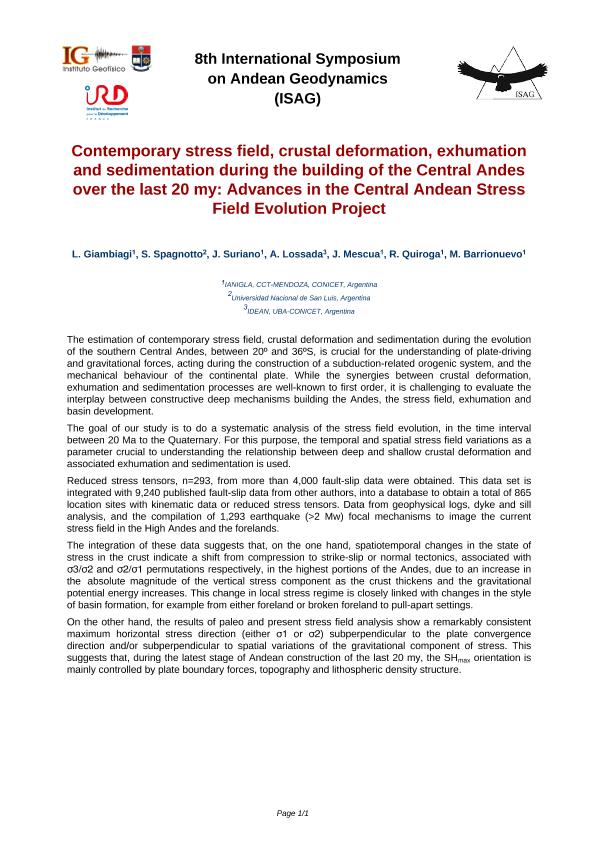Evento
Contemporary stress field, crustal deformation, exhumation and sedimentation during the building of the Central Andes over the last 20 my: Advances in the Central Andean Stress Field Evolution Project
Giambiagi, Laura Beatriz ; Spagnotto, Silvana Liz
; Spagnotto, Silvana Liz ; Suriano, Julieta
; Suriano, Julieta ; Lossada, Ana Clara
; Lossada, Ana Clara ; Mescua, Jose Francisco
; Mescua, Jose Francisco ; Quiroga Carrasco, Rodrigo Adolfo
; Quiroga Carrasco, Rodrigo Adolfo ; Barrionuevo, Matías
; Barrionuevo, Matías
 ; Spagnotto, Silvana Liz
; Spagnotto, Silvana Liz ; Suriano, Julieta
; Suriano, Julieta ; Lossada, Ana Clara
; Lossada, Ana Clara ; Mescua, Jose Francisco
; Mescua, Jose Francisco ; Quiroga Carrasco, Rodrigo Adolfo
; Quiroga Carrasco, Rodrigo Adolfo ; Barrionuevo, Matías
; Barrionuevo, Matías
Tipo del evento:
Simposio
Nombre del evento:
8th International Symposium on Andean Geodynamics
Fecha del evento:
24/09/2019
Institución Organizadora:
Escuela Politécnica Nacional;
Institut de Recherche pour le Développement;
Título del Libro:
8th International Symposium on Andean Geodynamics
Editorial:
International Society for Animal Genetics
Idioma:
Inglés
Clasificación temática:
Resumen
The estimation of contemporary stress field, crustal deformation and sedimentation during the evolution of the southern Central Andes, between 20º and 36ºS, is crucial for the understanding of plate-driving and gravitational forces, acting during the construction of a subduction-related orogenic system, and the mechanical behaviour of the continental plate. While the synergies between crustal deformation, exhumation and sedimentation processes are well-known to first order, it is challenging to evaluate the interplay between constructive deep mechanisms building the Andes, the stress field, exhumation and basin development.The goal of our study is to do a systematic analysis of the stress field evolution, in the time interval between 20 Ma to the Quaternary. For this purpose, the temporal and spatial stress field variations as a parameter crucial to understanding the relationship between deep and shallow crustal deformation and associated exhumation and sedimentation is used.Reduced stress tensors, n=293, from more than 4,000 fault-slip data were obtained. This data set is integrated with 9,240 published fault-slip data from other authors, into a database to obtain a total of 865 location sites with kinematic data or reduced stress tensors. Data from geophysical logs, dyke and sill analysis, and the compilation of 1,293 earthquake (>2 Mw) focal mechanisms to image the current stress field in the High Andes and the forelands.The integration of these data suggests that, on the one hand, spatiotemporal changes in the state of stress in the crust indicate a shift from compression to strike-slip or normal tectonics, associated with σ3/σ2 and σ2/σ1 permutations respectively, in the highest portions of the Andes, due to an increase in the absolute magnitude of the vertical stress component as the crust thickens and the gravitational potential energy increases. This change in local stress regime is closely linked with changes in the style of basin formation, for example from either foreland or broken foreland to pull-apart settings.On the other hand, the results of paleo and present stress field analysis show a remarkably consistent maximum horizontal stress direction (either σ1 or σ2) subperpendicular to the plate convergence direction and/or subperpendicular to spatial variations of the gravitational component of stress. This suggests that, during the latest stage of Andean construction of the last 20 my, the SHmax orientation is mainly controlled by plate boundary forces, topography and lithospheric density structure.
Palabras clave:
CENTRAL ANDES
,
Stress Field
,
Exhumation
,
Sedimentation
Archivos asociados
Licencia
Identificadores
Colecciones
Eventos(IANIGLA)
Eventos de INST. ARG. DE NIVOLOGIA, GLACIOLOGIA Y CS. AMBIENT
Eventos de INST. ARG. DE NIVOLOGIA, GLACIOLOGIA Y CS. AMBIENT
Eventos(IDEAN)
Eventos de INSTITUTO DE ESTUDIOS ANDINOS "DON PABLO GROEBER"
Eventos de INSTITUTO DE ESTUDIOS ANDINOS "DON PABLO GROEBER"
Citación
Contemporary stress field, crustal deformation, exhumation and sedimentation during the building of the Central Andes over the last 20 my: Advances in the Central Andean Stress Field Evolution Project; 8th International Symposium on Andean Geodynamics; Quito; Ecuador; 2019; 1-1
Compartir



